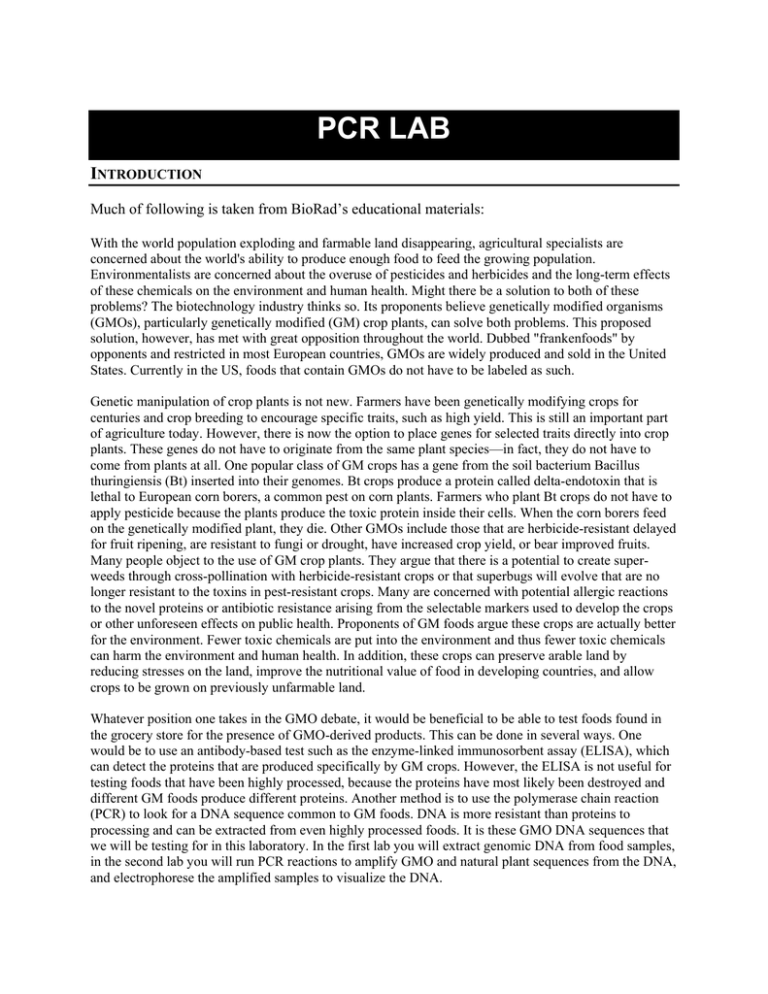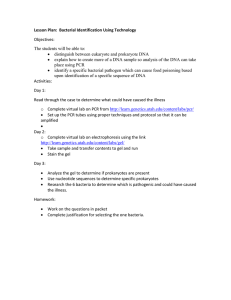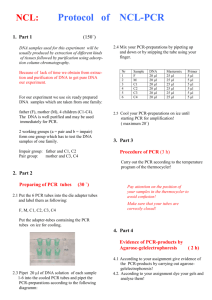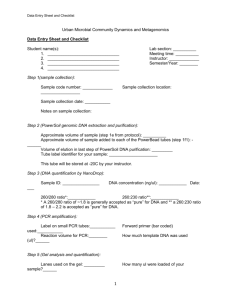PCR LAB I Much of following is taken from BioRad’s educational materials:
advertisement

PCR LAB INTRODUCTION Much of following is taken from BioRad’s educational materials: With the world population exploding and farmable land disappearing, agricultural specialists are concerned about the world's ability to produce enough food to feed the growing population. Environmentalists are concerned about the overuse of pesticides and herbicides and the long-term effects of these chemicals on the environment and human health. Might there be a solution to both of these problems? The biotechnology industry thinks so. Its proponents believe genetically modified organisms (GMOs), particularly genetically modified (GM) crop plants, can solve both problems. This proposed solution, however, has met with great opposition throughout the world. Dubbed "frankenfoods" by opponents and restricted in most European countries, GMOs are widely produced and sold in the United States. Currently in the US, foods that contain GMOs do not have to be labeled as such. Genetic manipulation of crop plants is not new. Farmers have been genetically modifying crops for centuries and crop breeding to encourage specific traits, such as high yield. This is still an important part of agriculture today. However, there is now the option to place genes for selected traits directly into crop plants. These genes do not have to originate from the same plant species—in fact, they do not have to come from plants at all. One popular class of GM crops has a gene from the soil bacterium Bacillus thuringiensis (Bt) inserted into their genomes. Bt crops produce a protein called delta-endotoxin that is lethal to European corn borers, a common pest on corn plants. Farmers who plant Bt crops do not have to apply pesticide because the plants produce the toxic protein inside their cells. When the corn borers feed on the genetically modified plant, they die. Other GMOs include those that are herbicide-resistant delayed for fruit ripening, are resistant to fungi or drought, have increased crop yield, or bear improved fruits. Many people object to the use of GM crop plants. They argue that there is a potential to create superweeds through cross-pollination with herbicide-resistant crops or that superbugs will evolve that are no longer resistant to the toxins in pest-resistant crops. Many are concerned with potential allergic reactions to the novel proteins or antibiotic resistance arising from the selectable markers used to develop the crops or other unforeseen effects on public health. Proponents of GM foods argue these crops are actually better for the environment. Fewer toxic chemicals are put into the environment and thus fewer toxic chemicals can harm the environment and human health. In addition, these crops can preserve arable land by reducing stresses on the land, improve the nutritional value of food in developing countries, and allow crops to be grown on previously unfarmable land. Whatever position one takes in the GMO debate, it would be beneficial to be able to test foods found in the grocery store for the presence of GMO-derived products. This can be done in several ways. One would be to use an antibody-based test such as the enzyme-linked immunosorbent assay (ELISA), which can detect the proteins that are produced specifically by GM crops. However, the ELISA is not useful for testing foods that have been highly processed, because the proteins have most likely been destroyed and different GM foods produce different proteins. Another method is to use the polymerase chain reaction (PCR) to look for a DNA sequence common to GM foods. DNA is more resistant than proteins to processing and can be extracted from even highly processed foods. It is these GMO DNA sequences that we will be testing for in this laboratory. In the first lab you will extract genomic DNA from food samples, in the second lab you will run PCR reactions to amplify GMO and natural plant sequences from the DNA, and electrophorese the amplified samples to visualize the DNA. PCR LAB 2 PCR LAB DAY 1 EXTRACTION OF DNA FROM FOOD SAMPLES In this lesson you will extract DNA from a control non-GMO food and a grocery store food item that you will test for the presence of GMOs. The most commonly modified foods are corn and soy-based, and so the test food could be fresh corn or soybeans, or a prepared or processed food such as cornmeal, cheese puffs, veggie sausage, etc. You will process the non-GMO control first. You will first weigh your food sample, then grind it with water to make a slurry. You will then add a tiny amount of the slurry to a screwcap tube containing InstaGene matrix and boil it for 5 minutes. The cellular contents you are releasing from the ground-up sample contain enzymes (DNases) that can degrade the DNA you are attempting to extract. The InstaGene matrix is made of negatively charged microscopic beads that “chelate” or grab metal ions out of solution. It chelates metal ions such as Mg2+, which is required as a cofactor in enzymatic reactions. When DNA is released from your sample in the presence of the InstaGene matrix, the charged beads grab the Mg2+ and make it unavailable to the enzymes that would degrade the DNA you are trying to extract. This allows you to extract DNA without degradation. Boiling the samples destroys these enzymes. After you centrifuge the samples to remove the InstaGene matrix and debris, the supernatant will contain intact extracted DNA. This extracted DNA will be used in the next part of the laboratory as your target DNA. MATERIALS 2 Screwcap tubes with 500 µl InstaGene matrix Beaker of distilled water Food samples Disposable plastic transfer pipets 2–20 µl micropipet (if preparing non-GMO food control) 2–20 µl pipet tips Mortar and pestle PROCEDURE 1. Work in groups of 4. 2. Find your screwcap tubes containing 500 µl of InstaGene matrix and label one “non-GMO” and one “test”. 3. Weigh out 1 g of the certified non-GMO food control and place in mortar. Using the transfer pipet, add 5 ml of distilled water using the graduations on the transfer pipet. 4. Grind with pestle for 2 minutes until a slurry is made. 5. Dilute with up to 5 ml water so that the slurry is smooth enough to pipet. 6. Pipet 50 µl slurry into the InstaGene matrix tube labeled “non-GMO”. Cap and shake well. 7. Repeat the above steps for your test food sample and place into “test” tube. 8. Place the two tubes into the 95 oC water bath for 5 min. 9. Remove tubes and centrifuge on maximum for 5 min. 3 PCR LAB PCR REACTIONS For this experiment you will set up two PCR reactions for each DNA sample, which makes 6 PCR reactions in total. One PCR reaction, using the plant master mix (PMM), is a control to determine whether or not you have successfully extracted plant DNA from your test food. This is done by identifying a DNA sequence that is common to all plants by using primers (colored green in the kit) that specifically amplify a section of a chloroplast gene used in the light reaction (photosystem II). Why is this necessary? What if you do not amplify DNA using the GMO primers? Can you conclude that your test food is not GM or might it just be that your DNA extraction was unsuccessful? If you amplify DNA using the plant primers, you can conclude that you successfully amplified DNA, therefore whether or not you amplify DNA with your GMO primers, you will have more confidence in the validity of your result. The second PCR reaction you carry out will determine whether or not your DNA sample contains GM DNA sequences. This is done by identifying DNA sequences that are common to most (~85%) of all GM plants using primers specific to these sequences. These primers are colored red and are in the GMO master mix (GMM). Why do you have to set up a PCR reaction with DNA from certified non-GMO food? What if some GMO-positive DNA got into the InstaGene or master mix from a dirty pipet tip or a previous class? This DNA could be amplified in your test food PCR reaction and give you a false result. By having a known non-GMO control that you know should not amplify the GMO target sequences, you can tell if your PCR reactions have been contaminated by GMO-positive DNA. MATERIALS GMO master mix (red) (on ice) Plant master mix (green) (on ice) GMO positive control DNA (on ice) Test food DNA Non-GMO food control DNA PCR tubes 6 PCR adaptors (Capless tubes) 6 2–20 µl adjustable-volume micropipet or fixed-volume 20 µl micropipet 2–20 µl pipet tips, aerosol barrier 1 rack Adaptor tubes are used for centrifugation of PCR tubes. Do NOT attempt to spin PCR tubes without an adaptor. 4 PCR LAB PROCEDURE 1. Number PCR tubes 1-6 on their lids. Follow table below to help you set up your reactions. Tube # 1 2 3 4 5 6 DNA 20 µl Non-GMO food control DNA 20 µl Non-GMO food control DNA 20 µl Test food DNA 20 µl Test food DNA 20 µl GMO positive control DNA 20 µl GMO positive control DNA Master Mix 20 µl Plant master mix (green) 20 µl GMO master mix (red) 20 µl Plant master mix (green) 20 µl GMO master mix (red) 20 µl Plant master mix (green) 20 µl GMO master mix (red) 2. Keep the tubes on ice for the remaining steps. 3. Using a fresh tip each time, add 20 µl of the indicated master mix to each tube. I.E. add 20 µl of green plant master mix (PMM) to tubes 1, 3, and 5. Then add 20 µl of red GMO master mix (GMM) to tubes 2, 4, and 6. Cap each tube. 4. Using a fresh pipet tip for each tube, add 20 µl of the DNA to each tube as indicated in the table above. Take care not to transfer any of the InstaGene beads to your PCR reaction. If the beads are disrupted, recentrifuge your DNA samples to pellet the beads. Add 20 µl of non-GMO food control DNA to tube 1 and pipet up and down to mix. Discard your tip. 5. Use a fresh tip to add 20 µl of non-GMO food control DNA to tube 2 and mix. Discard your tip. Similarly add 20 µl of test food DNA to tubes 3 & 4, and add 20 µl of GMO positive control DNA to tubes 5 & 6, changing your tip for every tube. 6. Add 50 µl of mineral oil to each reaction. Mineral oil will form a layer on top of your reactions and helps prevent evaporation during heating and cooling. 7. When instructed to, place the PCR tubes in the thermal cycler. DAY 2 GEL ELECTROPHORESIS You have completed your PCR amplification. You cannot, however, at this point determine whether or not you have PCR products. To do this, you must visualize your products. You will do this using gel electrophoresis. Your PCR product bands are very small compared to those in other DNA experiments you have done. Instead of using a HindIII digest of lambda DNA, we will use a low molecular weight ladder with fragments of 1000bp, 700bp, 500bp, 200bp, and 100bp to make your standard curve. The product band sizes in this lab are 455 bp for the plant primers and 200 bp for the GMO primers, so these fall within the range of the ladder. Also, our standard 1% gel would not separate these bands. Instead, a tighter gel matrix is needed to impede the movement of these bands so that they are separated more on the gel and can be seen. Therefore, you will use a 3% agarose gel. MATERIALS Gel - 3% agarose Samples from previous lab period Running buffer ( 1x TAE for agarose gels or 1x TBE for polyacrylamide gels) 5 PCR LAB Orange G loading dye 1 vial PCR molecular weight ruler 1 vial 2–20 µl adjustable-volume pipet or fixed-volume 20 µl micropipet 1–20 µl pipet tips Gel electrophoresis chamber (may be shared by 2 workstations) Power supply (may be shared by multiple workstations) PROCEDURE 1. Set up your gel electrophoresis apparatus as in previous labs. Pour your gels. 2. Using a fresh tip each time, add 10 µl of Orange G loading dye to each sample and mix well. 3. Load 20 µl of each sample onto your gel. 4. Load 20 µl of the PCR molecular mass ruler into lane 7 5. Run an agarose gel at 100 V for 30 minutes.Do not let the orange dye front migrate out of the agarose gel. 6. Stain gel with ethidium bromide for 5 min. Destain with a large volume of water for 5 min. 7. Take gel to photography station. QUESTIONS FOR YOUR REPORT (20 points) 1. Present an abstract of your work. Include: 1) what you set out to learn, 2) what procedures you performed, and 3) a summary of your data or discoveries. 2. Provide a picture of your gel with all lanes properly labeled. Did you find any unusual bands or anomalies on the gel? If so describe what you think these are. 3. Measure the bands (distance traveled in mm) in all of the lanes. Create a standard curve using the molecular weight standard (see Fig. 1). 4. Using your standard curve, estimate band sizes. Place all measurements and estimation data into a table. Include your molecular weight standard in the table. 5. Explain the purpose of each sample loaded onto each of the 7 lanes of the gel. (Think in terms of controls) 6. Based on your results, is the food your group tested genetically modified? What was the food tested? How do you know for sure? 7. In one cycle of PCR, describe what is happening at each step. 8. Explain why PCR fingerprinting has replaced blood typing in paternity tests. 9. (4 pts) Beside PCR, what other method could you use to prove the GMO status of your food? Describe your experimental design including your methods and what controls you would use. 6





